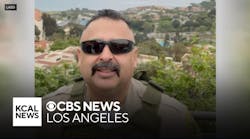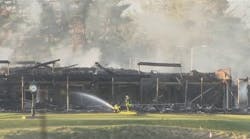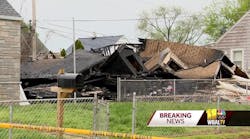We are all probably familiar with some form of non-verbal communication or another. It may be the form of communication that you use when you are cut off on the highway and you need to let the driver in the other car know that you thought you should have been first.
The form that we will be discussing is the form that comes from personal interaction with others. When you are talking to someone, are they looking away or yawning? When they do, it is hard to tell whether or not they are interested. When you roll your eyes and shrug your shoulders does that say "here we go again" or "whatever?"
Those are easy examples of non-verbal communication. You don't need a body language expert to tell you how your message is being received. We have all seen it or done it.
Where non-verbal communication is important in the fire service is in the way we act on the fireground. This is one of those times when it has nothing to do with what we say, it has all to say about what we do. If you are reminding your people to wear their gear when you are in the station and not doing it on the fireground, what message are you sending? This is when they will do as you do, not as you say. This is where you must lead by example. Make the point, "If I can do it, so can you."
I have a very bad habit of not wearing my firefighting gloves, not all the time, but occasionally. This has something to do with the gloves being more like oven mitts then anything else. That's not an excuse. At work I am a supervisor, and I have trained my people to do the work. It is not my place to do their work. It is my job to supervise. So I step back and watch out for them and make sure no one gets hurt. If I have my gloves on, I find myself more likely to be touching something I shouldn't be, and not watching out for them. No gloves, is my little reminder to keep my hands off. I won't get my hands dirty if I don't have my gloves on.
How you handle yourself on the fireground will send signals as well. A story recounted to me while critiquing a fire struck a nerve on how you can non-verbally communicate.
This fire occurred before I was promoted to lieutenant. An officer went home sick during the tour and the chief made me the acting lieutenant of the engine. The night was especially slow and I was beginning to wonder why. Then we were dispatched to an apartment fire on a block of high-end apartment buildings. Not the place where you would expect a false alarm. When we pulled up the windows failed from an apartment on the 10th floor. As the acting lieutenant of the engine, I transmitted the signal for a working fire and proceeded into the building.
When I got into the building I saw the superintendent who had come down from the apartment and confirmed a fire in the bedroom of apartment "10A." The occupant, an elderly woman, was still inside. As we got to the ninth floor to hook up to the standpipe, I gave them a few quick orders and went to the 10th floor to confirm the apartment location. The members completed the hose connections and brought the line to the 10th floor near the apartment door. I followed the truck into the apartment but we could not find the bedroom. The door to the narrow hall that led into the bedroom was paneled into the wall and was difficult to find. When the truck found the door and popped it open we were hit with a blast of heat and smoke.
The conditions in the hall to the bedroom prevented the truck from advancing the search until the engine could drive the fire back into the bedroom. I went back to the apartment door to get the rest of my guys, while the truck waited for our return. At the apartment door, I told the members what the conditions were and the route we would take with the line. I had the line charged and we advanced the line through the apartment and pushed the fire back into the bedroom. The fire conditions in the bedroom were unsurvivable for the elderly women.
That was the fire; the story that was told to me during the critique was what struck me. The junior man who was assigned to the nozzle position told me his story.
He said that they had stretched the line to the door and his heart was pounding because he knew we had a good fire. While he was at the apartment door waiting for me to return he felt the heat and saw all the smoke rolling out the door and he was apprehensive. The way he explained it was, when he saw me walking back to get them, my coat was not completely buttoned and I was speaking to him without a SCBA face piece on, and speaking slowly and calmly, he was reassured. I know, not smart; coat unbuttoned and no face piece on, but the point was, the way I spoke and what he sensed from my body language was what gave him confidence. He felt that if he just came out of there and he is not excited, "how bad could it be?" "What am I worried about, he's coming in with me."
My casual appearance and attitude in hindsight might have gotten us hurt. The last message you want to send is that firefighting is not dangerous, but it showed how experience and non-verbal communication will affect the actions of your firefighters. And yes, there was some part of this story that had to be spoken. Speaking in a calming tone can help keep the excitement level from getting ratcheted up.
Fire service leaders must always remember, even when you don't say anything, people are listening and watching. Someone will always be watching no matter what you do. Anyone who doesn't believe it has never been caught on videotape.
Comments are always welcomed. You can e-mail them to me at [email protected]. Stay safe.
CHRISTOPHER FLATLEY, a Firehouse.com Contributing Editor, is a 20-year veteran of the FDNY and a lieutenant currently assigned to Ladder Company 21 in Manhattan. Chris has twice served as chief of the Blauvelt, NY, Volunteer Fire Company and is currently the assistant chief and training coordinator. He is a nationally certified Fire Instructor 1 and is an instructor at the Rockland County, NY, Fire Training Center and holds a degree in fire protection technology. He is a Master Exercise Practitioner on the Exercise Design Team through the Center for Terrorism and Disaster Preparedness. You can reach Chris by e-mail at: [email protected].





